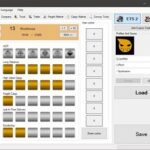The Cummins N14 Celect Plus engine, a staple in the trucking industry, is renowned for its power and durability. This article delves into the history of the N14, focusing on the Celect Plus variant, its specifications, and common problems encountered by owners and operators.
The N14, introduced in 1991 as the successor to the Cummins 855 Big Cam, built upon its predecessor’s robust design while incorporating advancements in electronic control systems. One of the most significant changes was the introduction of the Electronic Control Module (ECM), marking a shift towards electronic diagnostics in diesel engines.
The N14 Celect, the first Cummins engine with an electronic injection system, utilized a systematic pressure injection cycle controlled by the ECM. This paved the way for the N14 Celect Plus in 1997, which further refined the ECM’s control over the fuel system, allowing for greater customization and optimization.
The N14 also addressed oil consumption, a concern with the 855. Redesigned pistons and the introduction of API CF-4 and API CG-4 oils significantly reduced oil consumption and improved thermal stability.
Common Cummins N14 Celect Plus Injector Problems
Despite its overall reliability, the N14’s injectors and related electronics can present challenges. A frequent issue involves the ECM reporting error codes like 111 or 343, indicating a grounding problem with the injectors. This often starts with a single injector malfunction but can quickly escalate, necessitating immediate engine shutdown.
Early N14 models lacked protection against wiring harness shorts, potentially damaging the ECM. Replacing faulty injector wiring promptly is crucial to prevent further damage. A malfunctioning fuel solenoid, located beneath the ECM, can also overheat and damage critical components. Carrying spare injectors is a recommended practice.
Other common injector problems include:
- Crankcase overfilling due to injector overfueling
- Leaking injector O-rings
- Clogged filter screens causing misfires
- Injector cup failures leading to water contamination
- Over-revving causing scoring on the injector plunger barrel
- Clogged oil coolers
- Fraying fuel lines allowing debris into the injector
Fuel and Additives for the Cummins N14 Celect Plus
Using quality fuel and additives significantly impacts the N14’s performance and longevity. Many operators utilize Lucas oil additives or Automatic Transmission Fluid (ATF) solutions like Liquid Moly to prevent oil loss, protect seals, and clean sludge. While ATF additives offer benefits, their red color can be mistaken for off-road fuel at DOT inspections. Alcohol-based additives can combat algae growth in newer fuel blends, which can damage older fuel lines. Sourcing fuel from reputable suppliers is crucial, as the N14 is sensitive to overly chemically blended fuels.
Cummins N14 Celect Plus Maintenance and Longevity
Regular maintenance is key to maximizing the N14’s lifespan. Replacing oil, fuel, and coolant filters every 11,500 miles with high-quality options like Fleetguard or Donaldson is recommended. Valve adjustments are typically needed every 125,000 miles, while major overhauls are often not required until 500,000 to 1,000,000 miles.
Cummins N14 Celect Plus Specifications:
- Displacement: 14.0 Liters
- Bore: 5.5 inches (140 mm)
- Stroke: 6.0 inches (152 mm)
- Cylinders: 6 In-Line
- Fuel System: PT
- Horsepower: 310 – 525 HP @ 2100 RPM, 360 HP @ 1800 RPM (Marine)
- Aspiration: Turbocharged / Waterjacket Aftercooled / Naturally Aspirated Options
The Cummins N14 Celect Plus, despite its injector challenges, remains a powerful and durable engine. Understanding its history, specifications, and potential problems allows owners and operators to maintain these engines effectively and ensure their longevity.
